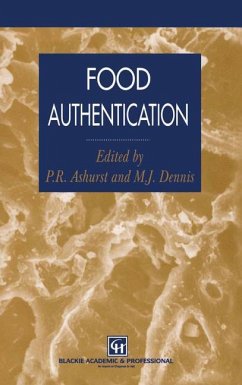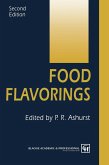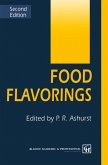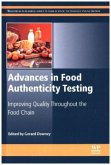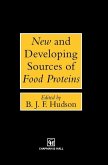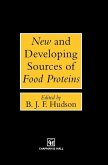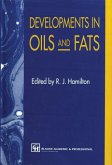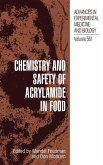- Broschiertes Buch
- Merkliste
- Auf die Merkliste
- Bewerten Bewerten
- Teilen
- Produkt teilen
- Produkterinnerung
- Produkterinnerung
The issue of food authenticity is not new. For centuries unscrupulous farmers and traders have attempted to 'extend', or othewise alter, their products to maximise revenues. In recent years the subject has reached new prominence and there even have been situations where food authenticity has featured as a newspaper headline in various countries. Food legislation covering the definition, and in some cases composition, of various commodities has been in place in developed countries for many years and paradoxically it is the legislative trend away from emphasis on composition and more on accurate…mehr
Andere Kunden interessierten sich auch für
![Food Flavorings Food Flavorings]() P. R. AshurstFood Flavorings39,99 €
P. R. AshurstFood Flavorings39,99 €![Food Flavorings Food Flavorings]() P. R. AshurstFood Flavorings75,99 €
P. R. AshurstFood Flavorings75,99 €![Advances in Food Authenticity Testing Advances in Food Authenticity Testing]() Advances in Food Authenticity Testing190,99 €
Advances in Food Authenticity Testing190,99 €![New and Developing Sources of Food Proteins New and Developing Sources of Food Proteins]() B. J. F. HudsonNew and Developing Sources of Food Proteins112,99 €
B. J. F. HudsonNew and Developing Sources of Food Proteins112,99 €![New and Developing Sources of Food Proteins New and Developing Sources of Food Proteins]() B. J. F. HudsonNew and Developing Sources of Food Proteins115,99 €
B. J. F. HudsonNew and Developing Sources of Food Proteins115,99 €![Developments in Oils and Fats Developments in Oils and Fats]() Developments in Oils and Fats39,99 €
Developments in Oils and Fats39,99 €![Chemistry and Safety of Acrylamide in Food Chemistry and Safety of Acrylamide in Food]() Chemistry and Safety of Acrylamide in Food149,99 €
Chemistry and Safety of Acrylamide in Food149,99 €-
-
-
The issue of food authenticity is not new. For centuries unscrupulous farmers and traders have attempted to 'extend', or othewise alter, their products to maximise revenues. In recent years the subject has reached new prominence and there even have been situations where food authenticity has featured as a newspaper headline in various countries. Food legislation covering the definition, and in some cases composition, of various commodities has been in place in developed countries for many years and paradoxically it is the legislative trend away from emphasis on composition and more on accurate and truthfullabeliing that has been one driving force for the authenticity issue. Another, and many would speculate as the more potent, driving force is the move towards fewer and larger supermarket chains in many countries. Such trading companies with their images of quality products, buying power and commercial standing, exercise considerable commercial power which has been claimed as a significant source of financial pressure on food prices and food commodity product quality. For whatever reason, recent food authenticity issues have become news and consumers, the media and enforcement authorities are showing more interest than ever before in the subject.
Produktdetails
- Produktdetails
- Verlag: Springer / Springer US / Springer, Berlin
- 1996
- Seitenzahl: 420
- Erscheinungstermin: 30. September 2011
- Englisch
- Abmessung: 235mm x 155mm x 23mm
- Gewicht: 650g
- ISBN-13: 9781461284260
- ISBN-10: 1461284260
- Artikelnr.: 41322614
- Herstellerkennzeichnung Die Herstellerinformationen sind derzeit nicht verfügbar.
- Verlag: Springer / Springer US / Springer, Berlin
- 1996
- Seitenzahl: 420
- Erscheinungstermin: 30. September 2011
- Englisch
- Abmessung: 235mm x 155mm x 23mm
- Gewicht: 650g
- ISBN-13: 9781461284260
- ISBN-10: 1461284260
- Artikelnr.: 41322614
- Herstellerkennzeichnung Die Herstellerinformationen sind derzeit nicht verfügbar.
1. An introduction to food authentication.- 1.1 The issue of authenticity.- 1.2 The significance of authenticity to food processors.- 1.3 Authenticity testing.- 1.4 Compositional standards.- 1.5 Labelling and legislation.- 1.6 Databases.- 1.7 Factors affecting choice of method for authenticity determination.- 1.8 Interpreting authenticity data.- 1.9 Due diligence.- 1.10 Introduction to the series.- References.- 2 Authenticity of fruit juices, jams and preserves.- 2.1 Introduction.- 2.2 Legal investigations.- 2.3 Analytical approaches.- 2.4 Fingerprinting techniques.- 2.5 Analysis of colours.- 2.6 Other methods.- 2.7 Jams and preserves.- 2.8 Conclusions.- Recent developments.- References.- 3 Wine authenticity.- 3.1 Introduction.- 3.2 Multidimensional analysis applied to wine.- 3.3 Distinction according to geography.- 3.4 Varieties.- 3.5 Age.- 3.6 Special examples.- 3.7 Conclusion.- References.- Further reading.- 4 Authenticity of meat and meat products.- 4.1 Introduction.- 4.2 Components of meat products.- 4.3 Examination procedures.- 4.4 Detection and determination of non-meat proteins.- 4.5 Mechanically recovered meat (MRM).- 4.6 Summary.- References.- 5 Authenticity of fish.- 5.1 Introduction.- 5.2 Objective methods of fish species identification.- 5.3 Principles of electrophoresis and isoelectric focusing.- 5.4 Separation systems.- 5.5 Nature of fish-flesh proteins.- 5.6 Experimental procedures for electrophoretic methods.- 5.7 Alternative protein-based methods of fish-species identification.- 5.8 DNA techniques of fish species identification.- 5.9 Fish eggs.- 5.10 General conclusions.- References.- 6 Authenticity of cereals.- 6.1 Introduction.- 6.2 Overview of techniques.- 6.3 Wheat and barley variety identification.- 6.4 Common wheat in durum pasta.- 6.5 Basmati rice.- 6.6 Conclusion.- References.- 7 Authenticity of vegetable oils.- 7.1 Introduction.- 7.2 Specific tests for identity and estimation of impurities.- 7.3 Fatty acid composition by GLC.- 7.4 Sterols and other minor components.- 7.5 Triglycerides.- 7.6 Data analysis techniques.- 7.7 Stable carbon isotope ratio analysis (SCIRA).- 7.8 Olive oil.- 7.9 Other vegetable oils.- 7.10 Castor oil in other oils.- 7.11 Mineral oil contamination.- 7.12 Animal fat in vegetable fat.- 7.13 Toxic oil syndrome.- 7.14 Conclusions.- References.- 8 Authenticity of honey.- 8.1 Introduction.- 8.2 Authenticity of honey.- 8.3 Methods for determining authenticity.- 8.4 Uncertainty resulting from variability in the natural product.- References.- 9 Authenticity of coffee.- 9.1 Introduction.- 9.2 Authenticity of green coffee.- 9.3 Authenticity of roasted coffee.- 9.4 Adulteration in roasted and ground coffee.- 9.5 Adulteration of soluble (instant) coffee.- 9.6 Adulteration in coffee/coffee-substitute blends.- 9.7 Authenticity of decaffeinated products.- 9.8 Conclusions.- References.- 10 Authentication of egg and egg products.- 10.1 Egg production.- 10.2 Grading.- 10.3 Methods for assessing egg classification.- 10.4 Incubated clears.- 10.5 Liquid eggs.- 10.6 Conclusions.- References.- 11 Other commodities.- 11.1 Introduction.- 11.2 Tea.- 11.3 Spices, herbs and condiments.- 11.4 Flavours and essences.- 11.5 Organic production of agricultural products.- 11.6 Natural mineral water.- 11.7 Genetically engineered organisms.- 11.8 Irradiated products.- References.- 12 Milk and milk products.- 12.1 Authenticity issues.- 12.2 Analytical methods for milk and milk product authenticity.- 12.3 Effects of adulteration on the market for milk products.- References.
1. An introduction to food authentication.
1.1 The issue of authenticity.
1.2 The significance of authenticity to food processors.
1.3 Authenticity testing.
1.4 Compositional standards.
1.5 Labelling and legislation.
1.6 Databases.
1.7 Factors affecting choice of method for authenticity determination.
1.8 Interpreting authenticity data.
1.9 Due diligence.
1.10 Introduction to the series.
References.
2 Authenticity of fruit juices, jams and preserves.
2.1 Introduction.
2.2 Legal investigations.
2.3 Analytical approaches.
2.4 Fingerprinting techniques.
2.5 Analysis of colours.
2.6 Other methods.
2.7 Jams and preserves.
2.8 Conclusions.
Recent developments.
References.
3 Wine authenticity.
3.1 Introduction.
3.2 Multidimensional analysis applied to wine.
3.3 Distinction according to geography.
3.4 Varieties.
3.5 Age.
3.6 Special examples.
3.7 Conclusion.
References.
Further reading.
4 Authenticity of meat and meat products.
4.1 Introduction.
4.2 Components of meat products.
4.3 Examination procedures.
4.4 Detection and determination of non
meat proteins.
4.5 Mechanically recovered meat (MRM).
4.6 Summary.
References.
5 Authenticity of fish.
5.1 Introduction.
5.2 Objective methods of fish species identification.
5.3 Principles of electrophoresis and isoelectric focusing.
5.4 Separation systems.
5.5 Nature of fish
flesh proteins.
5.6 Experimental procedures for electrophoretic methods.
5.7 Alternative protein
based methods of fish
species identification.
5.8 DNA techniques of fish species identification.
5.9 Fish eggs.
5.10 General conclusions.
References.
6 Authenticity of cereals.
6.1 Introduction.
6.2 Overview of techniques.
6.3 Wheat and barley variety identification.
6.4 Common wheat in durum pasta.
6.5 Basmati rice.
6.6 Conclusion.
References.
7 Authenticity of vegetable oils.
7.1 Introduction.
7.2 Specific tests for identity and estimation of impurities.
7.3 Fatty acid composition by GLC.
7.4 Sterols and other minor components.
7.5 Triglycerides.
7.6 Data analysis techniques.
7.7 Stable carbon isotope ratio analysis (SCIRA).
7.8 Olive oil.
7.9 Other vegetable oils.
7.10 Castor oil in other oils.
7.11 Mineral oil contamination.
7.12 Animal fat in vegetable fat.
7.13 Toxic oil syndrome.
7.14 Conclusions.
References.
8 Authenticity of honey.
8.1 Introduction.
8.2 Authenticity of honey.
8.3 Methods for determining authenticity.
8.4 Uncertainty resulting from variability in the natural product.
References.
9 Authenticity of coffee.
9.1 Introduction.
9.2 Authenticity of green coffee.
9.3 Authenticity of roasted coffee.
9.4 Adulteration in roasted and ground coffee.
9.5 Adulteration of soluble (instant) coffee.
9.6 Adulteration in coffee/coffee
substitute blends.
9.7 Authenticity of decaffeinated products.
9.8 Conclusions.
References.
10 Authentication of egg and egg products.
10.1 Egg production.
10.2 Grading.
10.3 Methods for assessing egg classification.
10.4 Incubated clears.
10.5 Liquid eggs.
10.6 Conclusions.
References.
11 Other commodities.
11.1 Introduction.
11.2 Tea.
11.3 Spices, herbs and condiments.
11.4 Flavours and essences.
11.5 Organic production of agricultural products.
11.6 Natural mineral water.
11.7 Genetically engineered organisms.
11.8 Irradiated products.
References.
12 Milk and milk products.
12.1 Authenticity issues.
12.2 Analytical methods for milk and milk product authenticity.
12.3 Effects of adulteration on the market for milk products.
References.
1.1 The issue of authenticity.
1.2 The significance of authenticity to food processors.
1.3 Authenticity testing.
1.4 Compositional standards.
1.5 Labelling and legislation.
1.6 Databases.
1.7 Factors affecting choice of method for authenticity determination.
1.8 Interpreting authenticity data.
1.9 Due diligence.
1.10 Introduction to the series.
References.
2 Authenticity of fruit juices, jams and preserves.
2.1 Introduction.
2.2 Legal investigations.
2.3 Analytical approaches.
2.4 Fingerprinting techniques.
2.5 Analysis of colours.
2.6 Other methods.
2.7 Jams and preserves.
2.8 Conclusions.
Recent developments.
References.
3 Wine authenticity.
3.1 Introduction.
3.2 Multidimensional analysis applied to wine.
3.3 Distinction according to geography.
3.4 Varieties.
3.5 Age.
3.6 Special examples.
3.7 Conclusion.
References.
Further reading.
4 Authenticity of meat and meat products.
4.1 Introduction.
4.2 Components of meat products.
4.3 Examination procedures.
4.4 Detection and determination of non
meat proteins.
4.5 Mechanically recovered meat (MRM).
4.6 Summary.
References.
5 Authenticity of fish.
5.1 Introduction.
5.2 Objective methods of fish species identification.
5.3 Principles of electrophoresis and isoelectric focusing.
5.4 Separation systems.
5.5 Nature of fish
flesh proteins.
5.6 Experimental procedures for electrophoretic methods.
5.7 Alternative protein
based methods of fish
species identification.
5.8 DNA techniques of fish species identification.
5.9 Fish eggs.
5.10 General conclusions.
References.
6 Authenticity of cereals.
6.1 Introduction.
6.2 Overview of techniques.
6.3 Wheat and barley variety identification.
6.4 Common wheat in durum pasta.
6.5 Basmati rice.
6.6 Conclusion.
References.
7 Authenticity of vegetable oils.
7.1 Introduction.
7.2 Specific tests for identity and estimation of impurities.
7.3 Fatty acid composition by GLC.
7.4 Sterols and other minor components.
7.5 Triglycerides.
7.6 Data analysis techniques.
7.7 Stable carbon isotope ratio analysis (SCIRA).
7.8 Olive oil.
7.9 Other vegetable oils.
7.10 Castor oil in other oils.
7.11 Mineral oil contamination.
7.12 Animal fat in vegetable fat.
7.13 Toxic oil syndrome.
7.14 Conclusions.
References.
8 Authenticity of honey.
8.1 Introduction.
8.2 Authenticity of honey.
8.3 Methods for determining authenticity.
8.4 Uncertainty resulting from variability in the natural product.
References.
9 Authenticity of coffee.
9.1 Introduction.
9.2 Authenticity of green coffee.
9.3 Authenticity of roasted coffee.
9.4 Adulteration in roasted and ground coffee.
9.5 Adulteration of soluble (instant) coffee.
9.6 Adulteration in coffee/coffee
substitute blends.
9.7 Authenticity of decaffeinated products.
9.8 Conclusions.
References.
10 Authentication of egg and egg products.
10.1 Egg production.
10.2 Grading.
10.3 Methods for assessing egg classification.
10.4 Incubated clears.
10.5 Liquid eggs.
10.6 Conclusions.
References.
11 Other commodities.
11.1 Introduction.
11.2 Tea.
11.3 Spices, herbs and condiments.
11.4 Flavours and essences.
11.5 Organic production of agricultural products.
11.6 Natural mineral water.
11.7 Genetically engineered organisms.
11.8 Irradiated products.
References.
12 Milk and milk products.
12.1 Authenticity issues.
12.2 Analytical methods for milk and milk product authenticity.
12.3 Effects of adulteration on the market for milk products.
References.
1. An introduction to food authentication.- 1.1 The issue of authenticity.- 1.2 The significance of authenticity to food processors.- 1.3 Authenticity testing.- 1.4 Compositional standards.- 1.5 Labelling and legislation.- 1.6 Databases.- 1.7 Factors affecting choice of method for authenticity determination.- 1.8 Interpreting authenticity data.- 1.9 Due diligence.- 1.10 Introduction to the series.- References.- 2 Authenticity of fruit juices, jams and preserves.- 2.1 Introduction.- 2.2 Legal investigations.- 2.3 Analytical approaches.- 2.4 Fingerprinting techniques.- 2.5 Analysis of colours.- 2.6 Other methods.- 2.7 Jams and preserves.- 2.8 Conclusions.- Recent developments.- References.- 3 Wine authenticity.- 3.1 Introduction.- 3.2 Multidimensional analysis applied to wine.- 3.3 Distinction according to geography.- 3.4 Varieties.- 3.5 Age.- 3.6 Special examples.- 3.7 Conclusion.- References.- Further reading.- 4 Authenticity of meat and meat products.- 4.1 Introduction.- 4.2 Components of meat products.- 4.3 Examination procedures.- 4.4 Detection and determination of non-meat proteins.- 4.5 Mechanically recovered meat (MRM).- 4.6 Summary.- References.- 5 Authenticity of fish.- 5.1 Introduction.- 5.2 Objective methods of fish species identification.- 5.3 Principles of electrophoresis and isoelectric focusing.- 5.4 Separation systems.- 5.5 Nature of fish-flesh proteins.- 5.6 Experimental procedures for electrophoretic methods.- 5.7 Alternative protein-based methods of fish-species identification.- 5.8 DNA techniques of fish species identification.- 5.9 Fish eggs.- 5.10 General conclusions.- References.- 6 Authenticity of cereals.- 6.1 Introduction.- 6.2 Overview of techniques.- 6.3 Wheat and barley variety identification.- 6.4 Common wheat in durum pasta.- 6.5 Basmati rice.- 6.6 Conclusion.- References.- 7 Authenticity of vegetable oils.- 7.1 Introduction.- 7.2 Specific tests for identity and estimation of impurities.- 7.3 Fatty acid composition by GLC.- 7.4 Sterols and other minor components.- 7.5 Triglycerides.- 7.6 Data analysis techniques.- 7.7 Stable carbon isotope ratio analysis (SCIRA).- 7.8 Olive oil.- 7.9 Other vegetable oils.- 7.10 Castor oil in other oils.- 7.11 Mineral oil contamination.- 7.12 Animal fat in vegetable fat.- 7.13 Toxic oil syndrome.- 7.14 Conclusions.- References.- 8 Authenticity of honey.- 8.1 Introduction.- 8.2 Authenticity of honey.- 8.3 Methods for determining authenticity.- 8.4 Uncertainty resulting from variability in the natural product.- References.- 9 Authenticity of coffee.- 9.1 Introduction.- 9.2 Authenticity of green coffee.- 9.3 Authenticity of roasted coffee.- 9.4 Adulteration in roasted and ground coffee.- 9.5 Adulteration of soluble (instant) coffee.- 9.6 Adulteration in coffee/coffee-substitute blends.- 9.7 Authenticity of decaffeinated products.- 9.8 Conclusions.- References.- 10 Authentication of egg and egg products.- 10.1 Egg production.- 10.2 Grading.- 10.3 Methods for assessing egg classification.- 10.4 Incubated clears.- 10.5 Liquid eggs.- 10.6 Conclusions.- References.- 11 Other commodities.- 11.1 Introduction.- 11.2 Tea.- 11.3 Spices, herbs and condiments.- 11.4 Flavours and essences.- 11.5 Organic production of agricultural products.- 11.6 Natural mineral water.- 11.7 Genetically engineered organisms.- 11.8 Irradiated products.- References.- 12 Milk and milk products.- 12.1 Authenticity issues.- 12.2 Analytical methods for milk and milk product authenticity.- 12.3 Effects of adulteration on the market for milk products.- References.
1. An introduction to food authentication.
1.1 The issue of authenticity.
1.2 The significance of authenticity to food processors.
1.3 Authenticity testing.
1.4 Compositional standards.
1.5 Labelling and legislation.
1.6 Databases.
1.7 Factors affecting choice of method for authenticity determination.
1.8 Interpreting authenticity data.
1.9 Due diligence.
1.10 Introduction to the series.
References.
2 Authenticity of fruit juices, jams and preserves.
2.1 Introduction.
2.2 Legal investigations.
2.3 Analytical approaches.
2.4 Fingerprinting techniques.
2.5 Analysis of colours.
2.6 Other methods.
2.7 Jams and preserves.
2.8 Conclusions.
Recent developments.
References.
3 Wine authenticity.
3.1 Introduction.
3.2 Multidimensional analysis applied to wine.
3.3 Distinction according to geography.
3.4 Varieties.
3.5 Age.
3.6 Special examples.
3.7 Conclusion.
References.
Further reading.
4 Authenticity of meat and meat products.
4.1 Introduction.
4.2 Components of meat products.
4.3 Examination procedures.
4.4 Detection and determination of non
meat proteins.
4.5 Mechanically recovered meat (MRM).
4.6 Summary.
References.
5 Authenticity of fish.
5.1 Introduction.
5.2 Objective methods of fish species identification.
5.3 Principles of electrophoresis and isoelectric focusing.
5.4 Separation systems.
5.5 Nature of fish
flesh proteins.
5.6 Experimental procedures for electrophoretic methods.
5.7 Alternative protein
based methods of fish
species identification.
5.8 DNA techniques of fish species identification.
5.9 Fish eggs.
5.10 General conclusions.
References.
6 Authenticity of cereals.
6.1 Introduction.
6.2 Overview of techniques.
6.3 Wheat and barley variety identification.
6.4 Common wheat in durum pasta.
6.5 Basmati rice.
6.6 Conclusion.
References.
7 Authenticity of vegetable oils.
7.1 Introduction.
7.2 Specific tests for identity and estimation of impurities.
7.3 Fatty acid composition by GLC.
7.4 Sterols and other minor components.
7.5 Triglycerides.
7.6 Data analysis techniques.
7.7 Stable carbon isotope ratio analysis (SCIRA).
7.8 Olive oil.
7.9 Other vegetable oils.
7.10 Castor oil in other oils.
7.11 Mineral oil contamination.
7.12 Animal fat in vegetable fat.
7.13 Toxic oil syndrome.
7.14 Conclusions.
References.
8 Authenticity of honey.
8.1 Introduction.
8.2 Authenticity of honey.
8.3 Methods for determining authenticity.
8.4 Uncertainty resulting from variability in the natural product.
References.
9 Authenticity of coffee.
9.1 Introduction.
9.2 Authenticity of green coffee.
9.3 Authenticity of roasted coffee.
9.4 Adulteration in roasted and ground coffee.
9.5 Adulteration of soluble (instant) coffee.
9.6 Adulteration in coffee/coffee
substitute blends.
9.7 Authenticity of decaffeinated products.
9.8 Conclusions.
References.
10 Authentication of egg and egg products.
10.1 Egg production.
10.2 Grading.
10.3 Methods for assessing egg classification.
10.4 Incubated clears.
10.5 Liquid eggs.
10.6 Conclusions.
References.
11 Other commodities.
11.1 Introduction.
11.2 Tea.
11.3 Spices, herbs and condiments.
11.4 Flavours and essences.
11.5 Organic production of agricultural products.
11.6 Natural mineral water.
11.7 Genetically engineered organisms.
11.8 Irradiated products.
References.
12 Milk and milk products.
12.1 Authenticity issues.
12.2 Analytical methods for milk and milk product authenticity.
12.3 Effects of adulteration on the market for milk products.
References.
1.1 The issue of authenticity.
1.2 The significance of authenticity to food processors.
1.3 Authenticity testing.
1.4 Compositional standards.
1.5 Labelling and legislation.
1.6 Databases.
1.7 Factors affecting choice of method for authenticity determination.
1.8 Interpreting authenticity data.
1.9 Due diligence.
1.10 Introduction to the series.
References.
2 Authenticity of fruit juices, jams and preserves.
2.1 Introduction.
2.2 Legal investigations.
2.3 Analytical approaches.
2.4 Fingerprinting techniques.
2.5 Analysis of colours.
2.6 Other methods.
2.7 Jams and preserves.
2.8 Conclusions.
Recent developments.
References.
3 Wine authenticity.
3.1 Introduction.
3.2 Multidimensional analysis applied to wine.
3.3 Distinction according to geography.
3.4 Varieties.
3.5 Age.
3.6 Special examples.
3.7 Conclusion.
References.
Further reading.
4 Authenticity of meat and meat products.
4.1 Introduction.
4.2 Components of meat products.
4.3 Examination procedures.
4.4 Detection and determination of non
meat proteins.
4.5 Mechanically recovered meat (MRM).
4.6 Summary.
References.
5 Authenticity of fish.
5.1 Introduction.
5.2 Objective methods of fish species identification.
5.3 Principles of electrophoresis and isoelectric focusing.
5.4 Separation systems.
5.5 Nature of fish
flesh proteins.
5.6 Experimental procedures for electrophoretic methods.
5.7 Alternative protein
based methods of fish
species identification.
5.8 DNA techniques of fish species identification.
5.9 Fish eggs.
5.10 General conclusions.
References.
6 Authenticity of cereals.
6.1 Introduction.
6.2 Overview of techniques.
6.3 Wheat and barley variety identification.
6.4 Common wheat in durum pasta.
6.5 Basmati rice.
6.6 Conclusion.
References.
7 Authenticity of vegetable oils.
7.1 Introduction.
7.2 Specific tests for identity and estimation of impurities.
7.3 Fatty acid composition by GLC.
7.4 Sterols and other minor components.
7.5 Triglycerides.
7.6 Data analysis techniques.
7.7 Stable carbon isotope ratio analysis (SCIRA).
7.8 Olive oil.
7.9 Other vegetable oils.
7.10 Castor oil in other oils.
7.11 Mineral oil contamination.
7.12 Animal fat in vegetable fat.
7.13 Toxic oil syndrome.
7.14 Conclusions.
References.
8 Authenticity of honey.
8.1 Introduction.
8.2 Authenticity of honey.
8.3 Methods for determining authenticity.
8.4 Uncertainty resulting from variability in the natural product.
References.
9 Authenticity of coffee.
9.1 Introduction.
9.2 Authenticity of green coffee.
9.3 Authenticity of roasted coffee.
9.4 Adulteration in roasted and ground coffee.
9.5 Adulteration of soluble (instant) coffee.
9.6 Adulteration in coffee/coffee
substitute blends.
9.7 Authenticity of decaffeinated products.
9.8 Conclusions.
References.
10 Authentication of egg and egg products.
10.1 Egg production.
10.2 Grading.
10.3 Methods for assessing egg classification.
10.4 Incubated clears.
10.5 Liquid eggs.
10.6 Conclusions.
References.
11 Other commodities.
11.1 Introduction.
11.2 Tea.
11.3 Spices, herbs and condiments.
11.4 Flavours and essences.
11.5 Organic production of agricultural products.
11.6 Natural mineral water.
11.7 Genetically engineered organisms.
11.8 Irradiated products.
References.
12 Milk and milk products.
12.1 Authenticity issues.
12.2 Analytical methods for milk and milk product authenticity.
12.3 Effects of adulteration on the market for milk products.
References.

